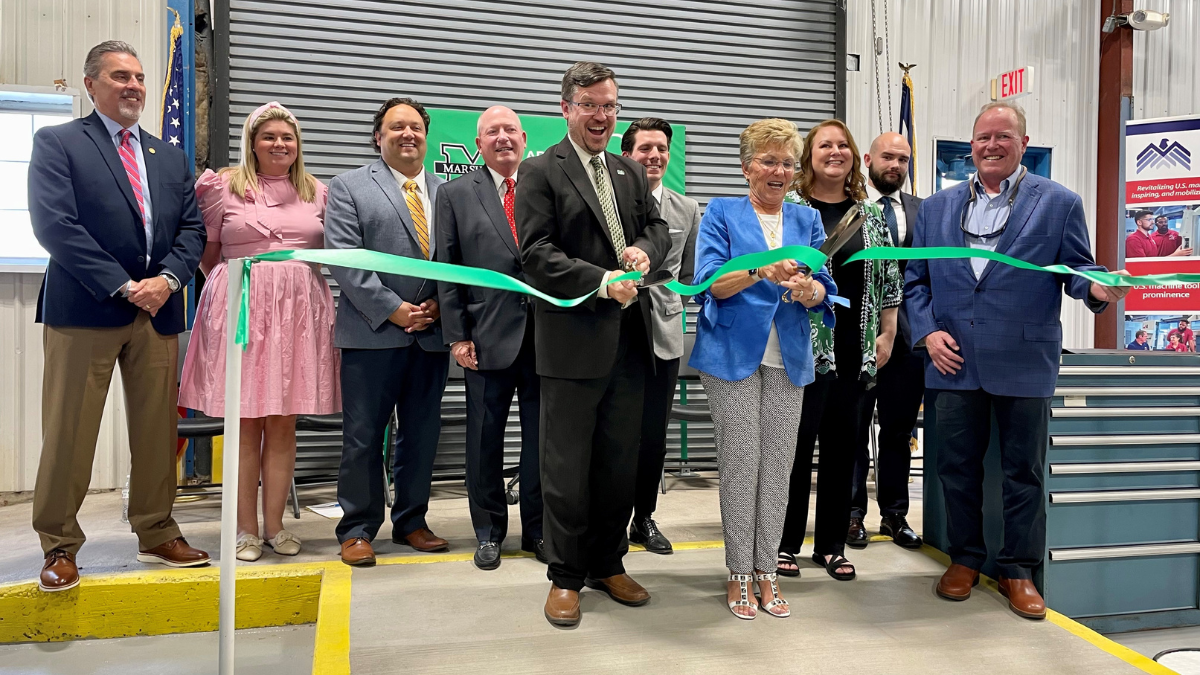The Marshall Advanced Manufacturing Training & Education Center (formerly Robert C. Byrd Institute) opened to much fanfare Wednesday at the West Virginia Regional Technology Park.
The training center will supply a reliable pipeline of skilled workers to manufacturing employers around the state.
Appalachian Regional Commission federal Co-Chair Gayle Manchin joined about 90 people for the ribbon cutting ceremony in South Charleston.
She said investing in workforce development in the Appalachian region will strengthen the state and country as a whole.
“It is about working together. It is about breaking down barriers between our communities, our states,” Manchin said. “If we lifted our boundaries between West Virginia, Kentucky, Tennessee, we wouldn’t know where to put them back. If we grow West Virginia, if we grow the Appalachian region our country will be stronger. We will be stronger as America and at the end of the day I think that’s what we all really wish for.”
Manchin pointed out that training programs offered through the center serve as an integral part of lifting up communities left behind by the coal industry.
“It’s very important to understand we’re not talking about a thing, ” Manchin said. “We’re not talking about a program, or a machine. We’re talking about people. It’s meeting people where they are and giving them opportunities that they didn’t have before. It’s making sure there is transportation, that there’s childcare, that people don’t come hungry into these programs. By creating an ecosystem for training, that’s how we build hope.”
“Hope for those who never could aspire to a four year college program. Hope for those that couldn’t adapt their lives to a 9-5 schedule and hope for those really interested in the trade, really interested in knowing how to run those machines.”
West Virginia Regional Technology Park CEO & Executive Director Matt Ballard and Derek Scarbro, interim director for Marshall Advanced Manufacturing Center were present for the event along with Joannie Harmon, workforce director with the Institute for Advanced Composites Manufacturing Innovation in Tennessee (IACMI).
“This is a really amazing initiative and so much hard work has gone into this,” Harmon said. “I know, because we started this conversation about a year and a half ago. It was kind of scary, I’m not going to lie. There were a lot of cobwebs and we weren’t sure what this was going to look like but it was amazing.”
Harmon said IACMI is one of 17 identified manufacturing institutes in the U.S. The organization works with the Department of Defense (DoD) and federal government which she said has “huge investments” in institutes with a focus on particular technology.
IACMI comprises a partnership of industry, universities, laboratories, and federal, state and local governments that work together to benefit the nation’s energy and economic security.
“We have an issue that machine tool technology has really declined in our country,” Harmon explained. “We don’t have the capabilities and capacity that we used to have 20-30 years ago. How do we get that back?”
Harmon said the Department of Defense formed a partnership with Oak Ridge National Laboratory in east Tennessee to create new technology around CNC machining to get more machinists with skills to work on big machine tools.
“This isn’t just another CNC training program, it’s a little different in that it is bringing in new technology,” Harmon explained. “What we are doing is working with our community colleges, technical colleges, high schools and universities like Marshall to get this new technology introduced into industry and into the workforce.”
IACMI introduced Marshall University to ACENet, a joint Department of Defense and Department of Energy (DOE) initiative launched in 2020. Its goal is to reestablish American leadership in the machine tool industry.
Marshall now delivers ACENet training to participants from Ohio, Tennessee and Kentucky.
CNC Master Machinist instructor Steve Nelson said the ability to manufacture precision parts and military components plays a role in national security.
“You see, on the other side of the room we have some CNC equipment that has some automatic functions and features,” Nelson said. “They are based on this equipment that has been made and used for over 100 years. Manufacturing, primarily CNC machining, welding and fabricating play a role in providing for DoD military equipment and items, it’s a vital component of our infrastructure.”
Carol Phillips, executive director of West Virginia Women Work said trainees from her program will work with Nelson to learn new manufacturing skills.
“Manufacturing in West Virginia is everywhere,” she said. “It’s a needed job in the state, it’s a high paying job in the state and that’s our goal – to get women into high paying careers.”
Currently, more than 1,000 manufacturing jobs are open in the Appalachian region.
